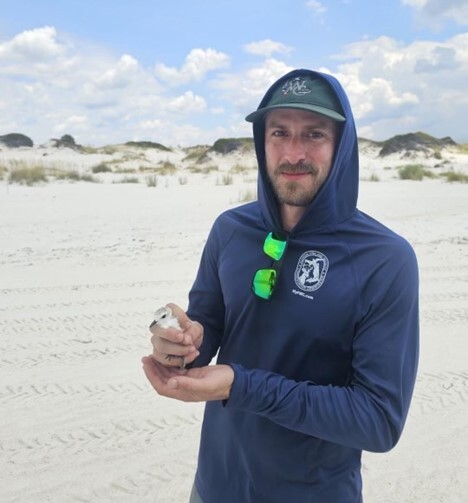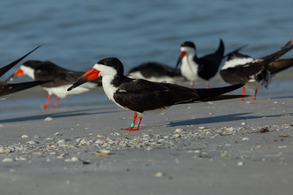Reminder
October 1. Florida Shorebird Database Data Entry Deadline.
Post-season Partnership Meetings
September 9. 1 to 3pm. Volusia County Partnership. In person and virtual by Teams. Email Jennifer Winters jwinters@volusia.org or Jaymie Reneker JReneker@volusia.org.
Thank You, FSA Partners!
The 2024 shorebird and seabird breeding season is coming to an end and the
conservation gains are a result of your hard work!
Each breeding season, a coordinated network of stewards, rooftop monitors, route surveyors, biologists and law enforcement officers make it possible for shorebirds to successfully nest along Florida’s coasts. Once again this season, FSA partners met new challenges with grit and grace to ensure a best-case breeding scenario for some of Florida's most charismatic coastal inhabitants.
To all of the volunteers, land managers, interns, students, officers, shorebird staff,
partnership coordinators and many others - THANK YOU - for your ongoing dedication
to raising another generation of Florida's shorebirds and seabirds. The vast network of
the Florida Shorebird Alliance makes breeding success possible and highlights the
ongoing need for partnership-driven conservation. Your dedication is priceless and
greatly appreciated!
To learn more about the successes and challenges from the breeding season, you're
invited to attend any FSA partnership meetings. They're free and open to the
public. Most post-season partnership meetings occur in October. Please contact a local FSA Partnership Coordinator for details about upcoming meetings.
New Data Quality Manager

Please welcome our new Data Quality Manager for the Shorebird Program, Rob Mulligan! He comes to us from the Avian Subsection of the FWC Fish and Wildlife Research Institute where he was primarily a field biologist who collaborated on many projects focused on state and federally listed avian species. He was also the database manager for the FWC Statewide Wading Bird Database and the state coordinator for the USGS Breeding Bird Survey. Rob has extensive field, data management, and outreach experience. We are excited to have him in his new role as Data Quality Manager for the Shorebird Program!
|
Connecting Coasts: Your Band Resight Data at Work
A recent study from the Florida Fish and Wildlife Research Institute highlights findings on waterbird connectivity between the Gulf of Mexico and the Atlantic Coast. The study, Connectivity of Atlantic and Gulf of Mexico Waterbird Populations, was published in the Florida Field Naturalist journal.
Researchers compiled data on 17 prioritized waterbird species based on their threat status in Florida, injuries related to the Deepwater Horizon oil spill, and the potential for targeted restoration efforts. For each prioritized species, they gathered band-resighting data from the United States Geological Survey (USGS) Bird Banding Lab (BBL), internal sources, collaborative partners, and a range of peer-reviewed and gray literature documenting connectivity through dispersal and movement patterns.
Thirteen of the 17 focal species (76%) exhibited coastal connectivity. Notably, birds like the Black Skimmer, Royal Tern, and Roseate Spoonbill demonstrated substantial connectivity between the two coasts.
By restoring breeding and foraging habitats along both of Florida’s coastlines, we have the potential to enhance the resilience of avian species that exhibit coastal connectivity. These findings show that efforts to grow populations of beach-nesting birds statewide can effectively safeguard imperiled species by mitigating risks associated with stressors such as hurricanes and oil spills.

Among the many collaborative efforts that contributed to this study, FSA partners played a crucial role in documenting coastal connectivity by reporting band resights in Florida. We extend our heartfelt thanks to all our FSA partners for their invaluable contribution! Your efforts are helping protect and restore our bird populations!
Dudek, S., W. Andrew Cox, and R. Pruner. 2024. Connectivity of Atlantic and Gulf of Mexico Waterbird Populations. Florida Field Naturalist 52(2): 41-52.
Photo by Britt Brown
|

The FSD closes for the season on October 1!
Another breeding season is coming to an end, which means it’s time to finish entering your monitoring data before the Florida Shorebird Database (FSD) closes on October 1! Every observation contributes valuable information about breeding shorebirds and seabirds, even if observations occurred outside count windows or after the final count window in August – we want to know about late season nesting and chick observations!
Now is also a good time to double-check the data you have already entered. All data entered into the FSD are reviewed to ensure that everything is collected and entered the same way across the state, is free of typos, and to bring additional clarity to any unique circumstances encountered during the season. While the data may make sense to those with intimate knowledge of the area, the data reviewers are here to ensure that anyone looking at the data can understand what happened during the season. You may have already heard from an FSD data reviewer!
To help out the data review process, here’s a quick checklist of things to look for:
Are nesting locations correct? Check to make sure the nesting sites are not located in the water or in heavily vegetated areas. Sometimes the map imagery does not match up with the on-the-ground reality. If the location is correct but doesn’t match the imagery, let us know by adding a comment to the site description confirming that the location is correct.
Do all your sites have a final outcome? Check if the last visit to each of your sites (solitary nests, ground colonies, and rooftops) provides a final outcome. If the last visit to a site is still ‘Active’ and you know when (or about when) the site became no longer active, edit your route survey accordingly. Ideally, you will be able to document a final outcome for all your sites, but for some late season sites this might not be possible.
For solitary nest sites, the final outcome ‘Complete’ means that the eggs hatched. If there isn’t a roving chick record to confirm that the nest hatched, please include a comment detailing the evidence that led you to mark the nest as complete.
For colony and rooftop sites, the final outcome ‘Complete’ means that the colony or rooftop produced at least one flight-capable chick. If there is not a flight-capable chick reported during a site visit, be sure to include a comment detailing the evidence that led you to consider the colony or rooftop to be ‘Complete’.
Are the count types accurate? Check that the count types for colony and rooftop sites are accurate. This is an easy place for typos to accidentally occur! If you could see the entire colony or rooftop, your count type is probably Direct. If you couldn’t see the entire colony or rooftop and you had to do a little bit of math to calculate the count, your count type was Extrapolated. If you’re unsure, you can consult our handy Count Types Guide.
Are there any typos? Look for duplicate entries, counts that seem unusually high or low (e.g., 200 vs. 20), or any other possible typos in the data.
Thank you for another dedicated season of shorebird monitoring! As always, feel free to email us at FLShorebirdDatabase@MyFWC.com if you have any questions, concerns, are unsure how to best enter data, or cannot make the October 1st deadline. We are happy to help!
Remembering Jen Eells
Jen was the FWC Assistant Regional Biologist for the North Central Region and the lead of the Nature Coast Partnership. Though her first love was small mammals, Jen’s passions extended to many species and ecosystems. She worked tirelessly to conserve imperiled wildlife and wild places in Florida, including beach mice, shorebirds and seabirds, wading birds, bats, amphibians, and crayfish.
Jen was tragically killed in an auto accident in July. She will be deeply missed by her many friends and colleagues.
|